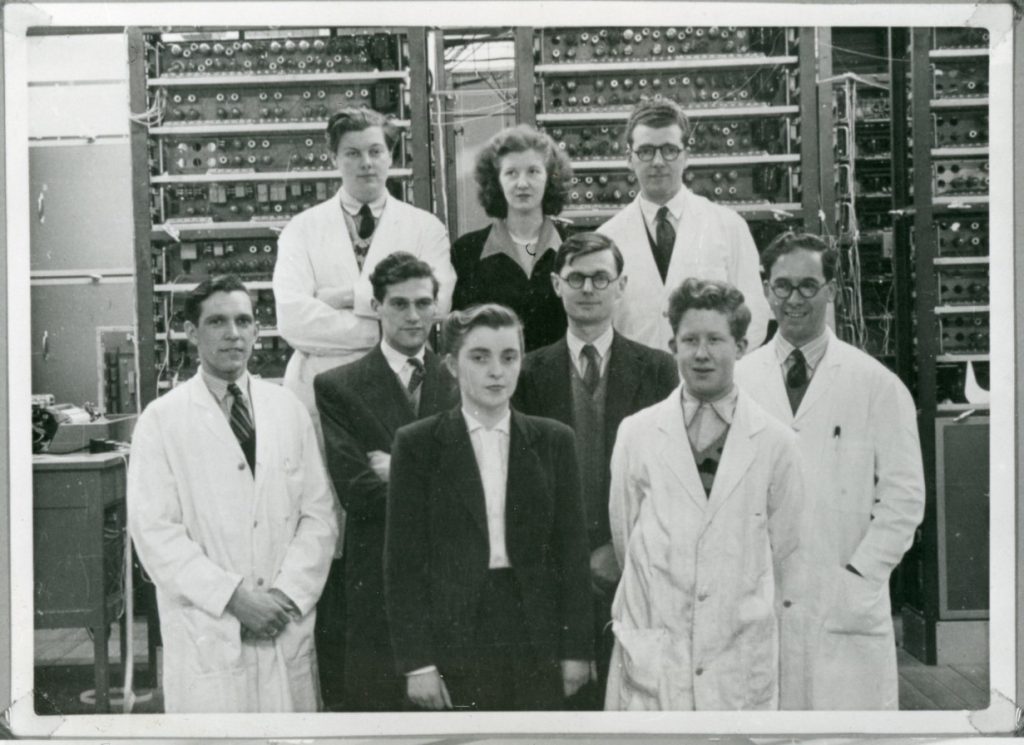Ray Shaw
LAST OF THE ORIGINAL DESIGN TEAM THAT BUILT LEO
Ray Shaw, the last remaining link with the original design team that built the world’s first business computer, LEO (Lyons Electronic Office) has died aged 98.
Recruited into J Lyons & Co in 1949 for his expertise in radar and radio telecommunications by the LEO hardware team leader, Dr John Pinkerton, he was involved initially with the development of special test equipment and testing schedules for basic units within LEO, but later worked on the design of many of the 90 circuits that went into the early LEO machines.
He went on to do design work on the LEO II development that enabled the system to operate four times faster by interleaving the pulses from the mercury delay line storage without major changes to the processor.
Shaw left Lyons in 1956 to work down under with, briefly, Amalgamated Wireless of Australia on component standardisation and specification, and then joined the University of Sydney Physics Department at The Adolf Basser Computing Laboratory to work on magnetic tape backing storage for the university’s computer, pioneering the use of error-correcting code techniques to minimise the loss of information due to magnetic tape flaws.
Returning to England in 1960 he joined English Electric Computers in Kidsgrove, Staffordshire, to work on the design of the KDF9 computer and then, by a strange twist of fate, found himself back with Pinkerton’s research group and LEO after English Electric’s takeover of the Lyons computer business in 1963.
Work on standards
His later work with LEO involved working on a number of high-profile projects involving advanced data transmission techniques, including research into packet-switching techniques and data transmission standards. The European Computer Manufacturers’ Association (ECMA) had a series of Technical Committees (TC’s) and Shaw was vice chairman of TC9 that was looking at data transmission and error correction techniques that would in time become part of the multi-layer model that supports the internet.
Raymond Denby Shaw was born in Ilford, Essex, the son of Eliza Shaw, nee Pember, and Frederick Alfred Shaw. He left school at 16 with little in the way of qualifications apart from a facility for mathematics.
He joined Jacob White & Co, a privately owned electrical and mechanical engineering workshop. Then, in 1940, he went on to work on the testing of thermionic radio valves with Standard Telephones & Cable Company in Sidcup, Kent. His main ambition at the time was to become involved in radio research, which led to a move to the Electro Physical Laboratories in Hendon, London, that were engaged in R&D work relating to photovoltaic detecting devices and systems. And thence to Vacuum Science Products at Norwood Junction, a company concerned with the development and manufacture of silver-caesium photoelectric devices.
In 1943, Shaw volunteered to serve in the Royal Air Force and was trained as a radar mechanic, becoming involved with airborne radar equipment and navigational aids and air-to-ground cathode ray tube displays both in the UK and in the Far East theatres of war. Demobilised with the rank of sergeant in 1947, he returned to his pre-service employers continuing work on photovoltaic photoelectric devices and studies in radio and telecommunication engineering.
Following the merger that created ICL in 1968 and through to 1980, when he retired from ICL, he was involved in the formulation of mainframe computing system requirements for future products. He was also prominent as the leader of an advanced team of trouble-shooters.
Founding member of BCS
A founding member of the British Computer Society, Ray Shaw’s many interests were reflected in a wide range of other memberships, including the Chartered Institute of British Management, the Defence Electronics History Society, and the British Society for the History of Mathematics.
He was married twice, but had no children. His first marriage, to Ann Twyford in 1952, ended in divorce in the 1970s. The second, to Muriel Fussel in 1982, ended with her death from cancer in 2005. His one sister, Eileen, pre-deceased him in 2015. He is survived by her children, Yvonne and Alan, and by five other nephews and nieces from Muriel’s side of the family.
Raymond Tempest Shaw, b. 17 April 1924, d. 27 November 2022
Remembering Ray Shaw a Video of John Daine’s presentation
Also on Dropbox

Ray Shaw (far left in front) with members of the early LEO build team, including its leader, Dr John Pinkerton (middle row, second from left with glasses)
An addendum from Dag Spicer
Thank you so much sending me this – I really appreciate the extra effort you make to include those of us who are a bit off-piste in terms of time zone!
What a wonderful presentation by John Daines. Please pass along with deep admiration my best wishes to him for a touching and informative talk.
I’ve downloaded the whole meeting and will be keeping it in my personal research archives – it’s a fine source of information on LEO, as are every LEO meetings.
The discussion about whether “LEO was cost effective” was interesting. My feeling on that is more relevant than whether it made sense economically was that Lyons would not have been able to grow at the rate it did without computers – they were facing a crisis of complexity that only computer methods could tackle. My $0.02. :_)
Thank you again for this amazing talk, Peter. I am honoured to be included.
With warmest regards,
Dag Spicer
Senior Curator
Computer History Museum
Editorial Board, IEEE Annals of the History of Computing
1401 N. Shoreline Blvd.
Mountain View CA 94043